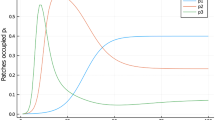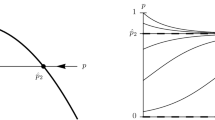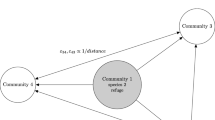Abstract
How two species interact during and after colonization influences which of them will be present in each stage of succession. In the tolerance model of ecological succession in a patchy environment, empty patches can be colonized by any species, but the ability to tolerate reduced resource levels determines which species will exclude the other. Here, we analyze a meta-population model of the possible roles of competition in colonization and succession, using non-linear Markov chains as a mathematical framework. Different kinds of competition affect the final equilibrial, abundances of the species involved in qualitatively different ways. An explicit criterion is given to determine which interactions have stronger effects on the final equilibrial levels of the weaker, species. Precise conditions are stated for the co-existence of both species. Both species are more likely to co-exist in the presence of an intermediate disturbance frequency.
Similar content being viewed by others
References
Barradas, I. and J. E. Cohen. 1994. Disturbances allow coexistence of competing species.J. Math. Biol. 32, 663–676.
Beddington, J. 1974. Age distribution and the stability of simple discrete time population models.J. Theor. Biol. 47, 65–74.
Caswell, H. and J. E. Cohen. 1991a. Communities in patchy environments: a model of disturbance, competition, and heterogeneity. In:Ecological Heterogeneity, J. Kolasa (Ed). Berlin: Springer.
Caswell, H. and J. E. Cohen. 1991b. Disturbance and diversity in metapopulations.Biol. J. Linnean Soc. 42, 193–218.
Caswell, H. and R. J. Etter. 1993. Ecological interactions in patchy environments: from patch-occupancy models to cellular automata. InPatch Dynamics, S. A. Levinet al. (Eds). New York: Springer Verlag.
Connell, J. H.. 1978. Diversity in tropical rain forest and coral reefs.Science 199, 1302–1310.
Connell, J. H. and R. O. Slatyer. 1977. Mechanisms of succession in natural communities and their role in community stability and organization.American Naturalist 111, 1119–1144.
Dayton, P. K. and R. R. Hessler. 1972. Role of biological disturbance in maintaining diversity in the deep sea.Deep Sea Research 19, 199–208.
Etter, R. J. and H. Caswell. 1993. The advantages of dispersal in a patchy environment: effects of disturbances in a cellular automaton model. InReproduction, Larval Biology and Recruitment in the Deep-Sea Benthos, K. J. Eckelbarger and C. M. Young (Eds). New York: Columbia University Press.
Gilpin M. E. 1975.Group Selection in Predator-Prey Communities. Princeton, NJ: Princeton University Press.
Huston, M. 1979. A general hypothesis of species diversity.American Naturalist 113, 81–101.
Hutchinson, G. E. 1951. Copepodology for the ornithologist.Ecology 32, 571–577.
Ricklefs, R. E. 1987. Community diversity: relative roles of local and regional processes.Science 235, 167–171.
Slatkin, M. 1974. Competition and regional coexistence.Ecology 55, 128–134.
Author information
Authors and Affiliations
Rights and permissions
About this article
Cite this article
Barradas, I., Caswell, H. & Cohen, J.E. Competition during colonization vs competition after colonization in disturbed environments: A metapopulation approach. Bltn Mathcal Biology 58, 1187–1207 (1996). https://doi.org/10.1007/BF02458389
Received:
Accepted:
Issue Date:
DOI: https://doi.org/10.1007/BF02458389




